How Grazing, Enclosure, and Mowing Intensities Shape Vegetation–Soil–Microbe Dynamics of Qinghai–Tibet Plateau Grasslands: Insights for Spatially Differentiated Integrated Management
Abstract
1. Introduction
2. Materials and Methods
2.1. Study Area
2.2. Methods
2.2.1. Data Sources and Search Strategy
2.2.2. Eligibility Criteria for Literature Selection
2.2.3. Meta-Analysis and Statistical Indicators
3. Results
3.1. Effects of Different Grassland Use on Vegetation Indicators
3.1.1. Vegetation Structure
3.1.2. Vegetation Biomass
3.1.3. Vegetation Diversity
3.2. Effects of Different Grassland Use on Soil Indicators
3.2.1. Soil Physical Properties
3.2.2. Soil Chemical Properties
3.3. Effects of Different Grassland Use on Microbial Indicators
3.3.1. Soil Microbial Biomass Carbon and Nitrogen
3.3.2. Biomass of Soil Bacteria, Fungi and Actinomycetes
3.3.3. Diversity of Soil Microbial Communities
4. Discussion
4.1. Spatially and Environmentally Heterogeneous Response Mechanisms
4.2. Implications for Scientific Research and Practical Management
4.3. Limitations and Future Research Directions
5. Conclusions
Funding
Institutional Review Board Statement
Informed Consent Statement
Data Availability Statement
Conflicts of Interest
References
- Li, C.; de Jong, R.; Schmid, B.; Wulf, H.; Schaepman, M.E. Changes in Grassland Cover and in Its Spatial Heterogeneity Indicate Degradation on the Qinghai-Tibetan Plateau. Ecol. Indic. 2020, 119, 106641. [Google Scholar] [CrossRef]
- Bardgett, R.D.; Bullock, J.M.; Lavorel, S.; Manning, P.; Schaffner, U.; Ostle, N.; Chomel, M.; Durigan, G.; Fry, E.L.; Johnson, D.; et al. Combatting Global Grassland Degradation. Nat. Rev. Earth Environ. 2021, 2, 720–735. [Google Scholar] [CrossRef]
- Li, T.; Sun, W.; Li, S.; Dai, E.; Fu, G. Temporal Stability of Plant Species α-Diversity in Alpine Grasslands of the Tibetan Plateau and Their Implications for Biodiversity Conservation. Agronomy 2025, 15, 1502. [Google Scholar] [CrossRef]
- Pei, L.; Wu, Z.; Qian, Y.; Li, X.; Zhang, J.; Sun, J.; Wang, Y. Plant Community Stability, Indicator Species and Their Driving Factors at a Gradient of Grazing Intensity in an Alpine Meadow. Ecol. Indic. 2024, 162, 112012. [Google Scholar] [CrossRef]
- Qian, D.; Du, Y.; Li, Q.; Guo, X.; Fan, B.; Cao, G. Impacts of Alpine Shrub-Meadow Degradation on Its Ecosystem Services and Spatial Patterns in Qinghai-Tibetan Plateau. Ecol. Indic. 2022, 135, 108541. [Google Scholar] [CrossRef]
- Wang, Y.; Lv, W.; Xue, K.; Wang, S.; Zhang, L.; Hu, R.; Zeng, H.; Xu, X.; Li, Y.; Jiang, L.; et al. Grassland Changes and Adaptive Management on the Qinghai–Tibetan Plateau. Nat. Rev. Earth Environ. 2022, 3, 668–683. [Google Scholar] [CrossRef]
- Zhang, H.; Liao, Z.; Yao, J.; Wang, T.; Xu, J.; Yan, B.; Liu, J. Response of Reduced Grassland Degradation Index to Climate Change in China. Agronomy 2024, 14, 1554. [Google Scholar] [CrossRef]
- Li, S.; Zhang, S.; Baskin, C.C.; Zhang, Z.; Xiao, S.; Bu, H.; Liu, Y.; Zhang, T.; Chen, S.; Liu, Q.; et al. Effect of Grazing and Nitrogen Addition on the Occurrence of Species with Different Seed Masses in Alpine Meadows on the Tibet Plateau. Sci. Total Environ. 2022, 838, 156531. [Google Scholar] [CrossRef]
- Wang, Z.; Song, W.; Yin, L. Responses in Ecosystem Services to Projected Land Cover Changes on the Tibetan Plateau. Ecol. Indic. 2022, 142, 109228. [Google Scholar] [CrossRef]
- Zhan, T.; Zhang, S.; Hua, T.; Sun, J.; Zhao, W. Spatiotemporal Variations in Alpine Grassland Quality and Its Response to Climate Change and Grazing Activity on the Qinghai-Tibet Plateau. Ecol. Front. 2025, in press. [Google Scholar] [CrossRef]
- Huang, X.; Shi, J.; Sun, W.; Sun, C.; Shen, X. Cultivation in an Alpine Region: Implications for Soil Bacteria. Agronomy 2023, 13, 296. [Google Scholar] [CrossRef]
- Wang, Y.; Ren, Z.; Ma, P.; Wang, Z.; Niu, D.; Fu, H.; Elser, J.J. Effects of Grassland Degradation on Ecological Stoichiometry of Soil Ecosystems on the Qinghai-Tibet Plateau. Sci. Total Environ. 2020, 722, 137910. [Google Scholar] [CrossRef] [PubMed]
- Guan, S.; Zhao, M.; Li, Y.; Xue, Z.; Tang, Z. Impact of Temperatures on Grassland Transfer Strategy: Evidence from the Qinghai-Tibet Plateau in China. J. Clean. Prod. 2024, 473, 143545. [Google Scholar] [CrossRef]
- Xue, R.; Wang, C.; Liu, M.; Zhang, D.; Li, K.; Li, N. A New Method for Soil Health Assessment Based on Analytic Hierarchy Process and Meta-Analysis. Sci. Total Environ. 2019, 650, 2771–2777. [Google Scholar] [CrossRef]
- Schneider, A.R.; Hering, D. Effects of Extensive Grazing and Mowing Compared to Abandonment on the Biodiversity of European Grasslands: A Meta-Analysis. Appl. Veg. Sci. 2024, 27, e70003. [Google Scholar] [CrossRef]
- Varga, K.; Csízi, I.; Halász, A.; Mezőszentgyörgyi, D.; Nagy, D. Monitoring the Degradation of Semi-Natural Grassland Associations under Different Land-Use Patterns. Agronomy 2024, 14, 35. [Google Scholar] [CrossRef]
- Ding, L.; Yan, Q.; Liu, P.; Yang, Q.; Henkin, Z.; Degen, A.A. Livestock Turnover and Dynamic Livestock Carrying Capacity Are Crucial Factors for Alpine Grassland Management: The Qinghai-Tibetan Plateau as a Case Study. J. Environ. Manag. 2024, 365, 121586. [Google Scholar] [CrossRef] [PubMed]
- Zhao, T.; Suo, R.; Alemu, A.W.; Zheng, J.; Zhang, F.; Iwaasa, A.D.; Guo, J.; Zhao, M.; Zhang, B. Mowing Increased Community Stability in Semiarid Grasslands More than Either Fencing or Grazing. Ecol. Appl. 2024, 34, e2985. [Google Scholar] [CrossRef]
- Cao, F.; Li, W.; Jiang, Y.; Gan, X.; Zhao, C.; Ma, J. Effects of Grazing on Grassland Biomass and Biodiversity: A Global Synthesis. Field Crops Res. 2024, 306, 109204. [Google Scholar] [CrossRef]
- Song, Y.; Liu, T.; Han, X.; Lu, Y.; Xu, X.; Wang, L.; Liao, Z.; Dong, Z.; Jiao, R.; Liang, W.; et al. Adaptive Traits of Three Dominant Desert-Steppe Species under Grazing-Related Degradation: Morphology, Structure, and Function. Glob. Ecol. Conserv. 2021, 28, e01647. [Google Scholar] [CrossRef]
- Wang, L.; Yan, L.; Zhang, J.; Lu, F.; Ouyang, Z. Spatiotemporal Patterns and Alleviating of Grassland Overgrazing under Current and Future Conditions in Qinghai-Tibet Plateau. J. Environ. Manag. 2025, 376, 124456. [Google Scholar] [CrossRef]
- Chen, X.; Wang, X.; Song, Y.; Chi, Y. A Review of Studies on the Effects of Anthropogenic Disturbances on Plant–Soil–Microorganism Interactions in Grassland Ecosystems: Based on Grazing and Tourism Perspectives. Agronomy 2024, 14, 2890. [Google Scholar] [CrossRef]
- Millett, J.; van Soest, M.A.J.; Edmondson, S.; Gahan, P.; Hunt, N.; Mercer, D.; O’Brien, J.; Smith, B.; Webster, C.; Dwyer, C. Perspectives on Conservation Grazing: The Need for Monitoring and Communication. Ecol. Solut. Evid. 2025, 6, e70085. [Google Scholar] [CrossRef]
- Li, D.; Nie, Y.; Xu, L.; Ye, L. Enclosure in Combination with Mowing Simultaneously Promoted Grassland Biodiversity and Biomass Productivity. Plants 2022, 11, 2037. [Google Scholar] [CrossRef]
- Huang, X.; Liu, X.; Liao, L.; Li, J.; Luo, G.; Li, B.; Ma, Z.; Wang, Z. Grazing Decreases Carbon Storage in the Qinghai-Tibet Plateau Grasslands. Commun. Earth Environ. 2025, 6, 198. [Google Scholar] [CrossRef]
- Hao, X.; Yang, J.; Dong, S.; Shen, H.; He, F.; Zhi, Y.; Kwaku, E.A.; Tu, D.; Dou, S.; Zhou, X.; et al. Impacts of Short-Term Grazing Intensity on the Plant Diversity and Ecosystem Function of Alpine Steppe on the Qinghai–Tibetan Plateau. Plants 2022, 11, 1889. [Google Scholar] [CrossRef]
- Yu, Z.; Ren, Y.; Du, W.; Yang, Y. Selecting Fore and Succeeding Crops to Construct a Double-Cropping System That Increases the Forage Yields of Alpine Pastoral Areas on the Qinghai–Tibetan Plateau. Agronomy 2025, 15, 904. [Google Scholar] [CrossRef]
- Li, W.; Shang, X.; Yan, H.; Xu, J.; Liang, T.; Zhou, H. Impact of Restoration Measures on Plant and Soil Characteristics in the Degraded Alpine Grasslands of the Qinghai Tibetan Plateau: A Meta-Analysis. Agric. Ecosyst. Environ. 2023, 347, 108394. [Google Scholar] [CrossRef]
- Dong, S. Revitalizing the Grassland on the Qinghai–Tibetan Plateau. Grassl. Res. 2023, 2, 241–250. [Google Scholar] [CrossRef]
- Liu, X.; Wang, Z.; Zheng, K.; Han, C.; Li, L.; Sheng, H.; Ma, Z. Changes in Soil Carbon and Nitrogen Stocks Following Degradation of Alpine Grasslands on the Qinghai-Tibetan Plateau: A Meta-Analysis. Land Degrad. Dev. 2021, 32, 1262–1273. [Google Scholar] [CrossRef]
- Harris, R.B. Rangeland Degradation on the Qinghai-Tibetan Plateau: A Review of the Evidence of Its Magnitude and Causes. J. Arid. Environ. 2010, 74, 1–12. [Google Scholar] [CrossRef]
- Zhu, Q.; Chen, H.; Peng, C.; Liu, J.; Piao, S.; He, J.-S.; Wang, S.; Zhao, X.; Zhang, J.; Fang, X.; et al. An Early Warning Signal for Grassland Degradation on the Qinghai-Tibetan Plateau. Nat. Commun. 2023, 14, 6406. [Google Scholar] [CrossRef]
- Dai, L.; Fu, R.; Guo, X.; Ke, X.; Du, Y.; Zhang, F.; Cao, G. Effect of Grazing Management Strategies on Alpine Grassland on the Northeastern Qinghai-Tibet Plateau. Ecol. Eng. 2021, 173, 106418. [Google Scholar] [CrossRef]
- Su, J.; Zhao, Y.; Xu, F.; Bai, Y. Multiple Global Changes Drive Grassland Productivity and Stability: A Meta-Analysis. J. Ecol. 2022, 110, 2850–2869. [Google Scholar] [CrossRef]
- Blanco-Canqui, H. Biochar and Soil Physical Properties. Soil Sci. Soc. Am. J. 2017, 81, 687–711. [Google Scholar] [CrossRef]
- Zhang, Y.; Wang, J.; Feng, Y. The Effects of Biochar Addition on Soil Physicochemical Properties: A Review. Catena 2021, 202, 105284. [Google Scholar] [CrossRef]
- Zhan, T.; Zhang, Z.; Sun, J.; Liu, M.; Zhang, X.; Peng, F.; Tsunekawa, A.; Zhou, H.; Gou, X.; Fu, S. Meta-Analysis Demonstrating That Moderate Grazing Can Improve the Soil Quality across China’s Grassland Ecosystems. Appl. Soil Ecol. 2020, 147, 103438. [Google Scholar] [CrossRef]
- Tälle, M.; Deák, B.; Poschlod, P.; Valkó, O.; Westerberg, L.; Milberg, P. Grazing vs. Mowing: A Meta-Analysis of Biodiversity Benefits for Grassland Management. Agric. Ecosyst. Environ. 2016, 222, 200–212. [Google Scholar] [CrossRef]
- Li, H.; Qiu, Y.; Yao, T.; Han, D.; Gao, Y.; Zhang, J.; Ma, Y.; Zhang, H.; Yang, X. Nutrients Available in the Soil Regulate the Changes of Soil Microbial Community alongside Degradation of Alpine Meadows in the Northeast of the Qinghai-Tibet Plateau. Sci. Total Environ. 2021, 792, 148363. [Google Scholar] [CrossRef]
- Wu, M.-H.; Xue, K.; Wei, P.-J.; Jia, Y.-L.; Zhang, Y.; Chen, S.-Y. Soil Microbial Distribution and Assembly Are Related to Vegetation Biomass in the Alpine Permafrost Regions of the Qinghai-Tibet Plateau. Sci. Total Environ. 2022, 834, 155259. [Google Scholar] [CrossRef]
- Huang, S.; Song, W.; Gao, H.; Cao, C.; Li, J.; Liu, B.; Yu, H.; Li, S.; Wei, X.; Sheng, S. Association between Ecological Risks and Ecosystem Services in an Urban Agglomeration in Arid China. Front. Environ. Sci. 2023, 10, 1101080. [Google Scholar] [CrossRef]
- Zhang, Y.; Ding, M.; Zhang, H.; Wang, N.; Xiao, F.; Yu, Z.; Huang, P.; Zou, F. Variations and Mutual Relations of Vegetation–Soil–Microbes of Alpine Meadow in the Qinghai-Tibet Plateau under Degradation and Cultivation. Land 2022, 11, 396. [Google Scholar] [CrossRef]
- Du, Z.; Ji, X.; Zhao, W.; Jiang, J.; He, Z.; Liu, H.; Gao, J.; Wang, X. Integrating Revised DPSIR and Ecological Security Patterns to Assess the Health of Alpine Grassland Ecosystems on the Qinghai–Tibet Plateau. Sci. Total Environ. 2024, 957, 177833. [Google Scholar] [CrossRef] [PubMed]
- Zhan, T.; Zhang, S.; Zhao, W. Adaptive Management for Alpine Grassland of the Tibetan Plateau Based on a Multi-Criteria Assessment. Front. Plant Sci. 2025, 16, 1518721. [Google Scholar] [CrossRef]
- Tan, Y.; Xu, Y.; Dong, S.; Zhao, X.; Yang, M.; Fan, T.; Wang, Q. Cooperative Management Reduces the Trade-Offs of Multi-Functions of the Grasslands on the Qinghai-Tibetan Plateau. Land Use Policy 2024, 146, 107309. [Google Scholar] [CrossRef]
- Das, P.P.; Singh, K.R.; Nagpure, G.; Mansoori, A.; Singh, R.P.; Ghazi, I.A.; Kumar, A.; Singh, J. Plant-Soil-Microbes: A Tripartite Interaction for Nutrient Acquisition and Better Plant Growth for Sustainable Agricultural Practices. Environ. Res. 2022, 214, 113821. [Google Scholar] [CrossRef] [PubMed]
- Yang, D.; Song, W. Tracking Land Use Trajectory to Map Abandoned Farmland in Mountainous Area. Ecol. Inf. 2023, 75, 102103. [Google Scholar] [CrossRef]
- Yang, M.; Dong, S.; Dong, Q.; Xu, Y.; Zhi, Y.; Liu, W.; Zhao, X. Trade-Offs in Ecological, Productivity and Livelihood Dimensions Inform Sustainable Grassland Management: Case Study from the Qinghai-Tibetan Plateau. Agric. Ecosyst. Environ. 2021, 313, 107377. [Google Scholar] [CrossRef]
- Milazzo, F.; Francksen, R.M.; Abdalla, M.; Ravetto Enri, S.; Zavattaro, L.; Pittarello, M.; Hejduk, S.; Newell-Price, P.; Schils, R.L.M.; Smith, P.; et al. An Overview of Permanent Grassland Grazing Management Practices and the Impacts on Principal Soil Quality Indicators. Agronomy 2023, 13, 1366. [Google Scholar] [CrossRef]
- Liu, K.; Shao, X. Grassland Ecological Management and Utilization for Sustainability. Agronomy 2024, 14, 149. [Google Scholar] [CrossRef]
- Zhao, Z.; Dai, E. Vegetation Cover Dynamics and Its Constraint Effect on Ecosystem Services on the Qinghai-Tibet Plateau under Ecological Restoration Projects. J. Environ. Manag. 2024, 356, 120535. [Google Scholar] [CrossRef]
- Jing, L.; Mipam, T.D.; Ai, Y.; Jiang, A.; Gan, T.; Zhang, S.; Liu, J.; Tian, L. Grazing Intensity Alters Soil Microbial Diversity and Network Complexity in Alpine Meadow on the Qinghai-Tibet Plateau. Agric. Ecosyst. Environ. 2023, 353, 108541. [Google Scholar] [CrossRef]
- Liu, L.; Zhao, G.; An, Z.; Mu, X.; Jiao, J.; An, S.; Tian, P. Effect of Grazing Intensity on Alpine Meadow Soil Quality in the Eastern Qinghai-Tibet Plateau, China. Ecol. Indic. 2022, 141, 109111. [Google Scholar] [CrossRef]
- Zhang, M.; Hu, J.; Zhang, Y.; Cao, Y.; Rensing, C.; Dong, Q.; Hou, F.; Zhang, J. Roles of the Soil Microbiome in Sustaining Grassland Ecosystem Health on the Qinghai-Tibet Plateau. Microbiol. Res. 2025, 293, 128078. [Google Scholar] [CrossRef] [PubMed]
- Zhao, J.; Liu, G.; Zhang, T.; Shao, M.; Dong, Y.; Wang, L.; Cui, X.; Wu, X. Plant Functional Diversity of Alpine Grasslands in the Central and Eastern Qinghai-Tibet Plateau. Res. Cold Arid. Reg. 2025, in press. [Google Scholar] [CrossRef]
- Sun, C.; An, H.; Liu, W.; Lv, W.; Li, M.; Yang, X.; Dong, Q. Light Grazing Increased but Heavy Grazing Decreased the Abundance and Family Richness of Soil Arthropods Community in an Alpine Grassland in the Qinghai Lake Basin. Sci. Total Environ. 2024, 957, 177549. [Google Scholar] [CrossRef]
- Zhang, Y.; Shi, G.; Wen, J.; Zhang, Y.; Wang, B. Response of Vegetation Productivity and Resilience to Extreme Climate Events under a Grazing Pressure Gradient on the Qinghai-Tibetan Plateau. J. Environ. Manag. 2025, 392, 126851. [Google Scholar] [CrossRef]
- Liu, J.; Qin, K.; Xie, G. Synergistic Enhancement of Ecosystem Services on the Qinghai-Tibet Plateau: Bridging Conservation and Development. Ecol. Indic. 2025, 179, 114193. [Google Scholar] [CrossRef]
- Wang, Y.; Liu, X.; Wang, T.; Zhang, X.; Feng, Y.; Yang, G.; Zhen, W. Relating Land-Use/Land-Cover Patterns to Water Quality in Watersheds Based on the Structural Equation Modeling. Catena 2021, 206, 105566. [Google Scholar] [CrossRef]
- Maaz, T.M.; Heck, R.H.; Glazer, C.T.; Loo, M.K.; Zayas, J.R.; Krenz, A.; Beckstrom, T.; Crow, S.E.; Deenik, J.L. Measuring the Immeasurable: A Structural Equation Modeling Approach to Assessing Soil Health. Sci. Total Environ. 2023, 870, 161900. [Google Scholar] [CrossRef]
- Jiang, S.; Meng, J.; Zhu, L.; Cheng, H. Spatial-Temporal Pattern of Land Use Conflict in China and Its Multilevel Driving Mechanisms. Sci. Total Environ. 2021, 801, 149697. [Google Scholar] [CrossRef] [PubMed]
- Nguyen, H.A.T.; Sophea, T.; Gheewala, S.H.; Rattanakom, R.; Areerob, T.; Prueksakorn, K. Integrating Remote Sensing and Machine Learning into Environmental Monitoring and Assessment of Land Use Change. Sustain. Prod. Consum. 2021, 27, 1239–1254. [Google Scholar] [CrossRef]
- Mhanna, S.; Halloran, L.J.S.; Zwahlen, F.; Asaad, A.H.; Brunner, P. Using Machine Learning and Remote Sensing to Track Land Use/Land Cover Changes Due to Armed Conflict. Sci. Total Environ. 2023, 898, 165600. [Google Scholar] [CrossRef] [PubMed]
- Zhang, Z.; Hu, B.; Jiang, W.; Qiu, H. Spatial and Temporal Variation and Prediction of Ecological Carrying Capacity Based on Machine Learning and PLUS Model. Ecol. Indic. 2023, 154, 110611. [Google Scholar] [CrossRef]
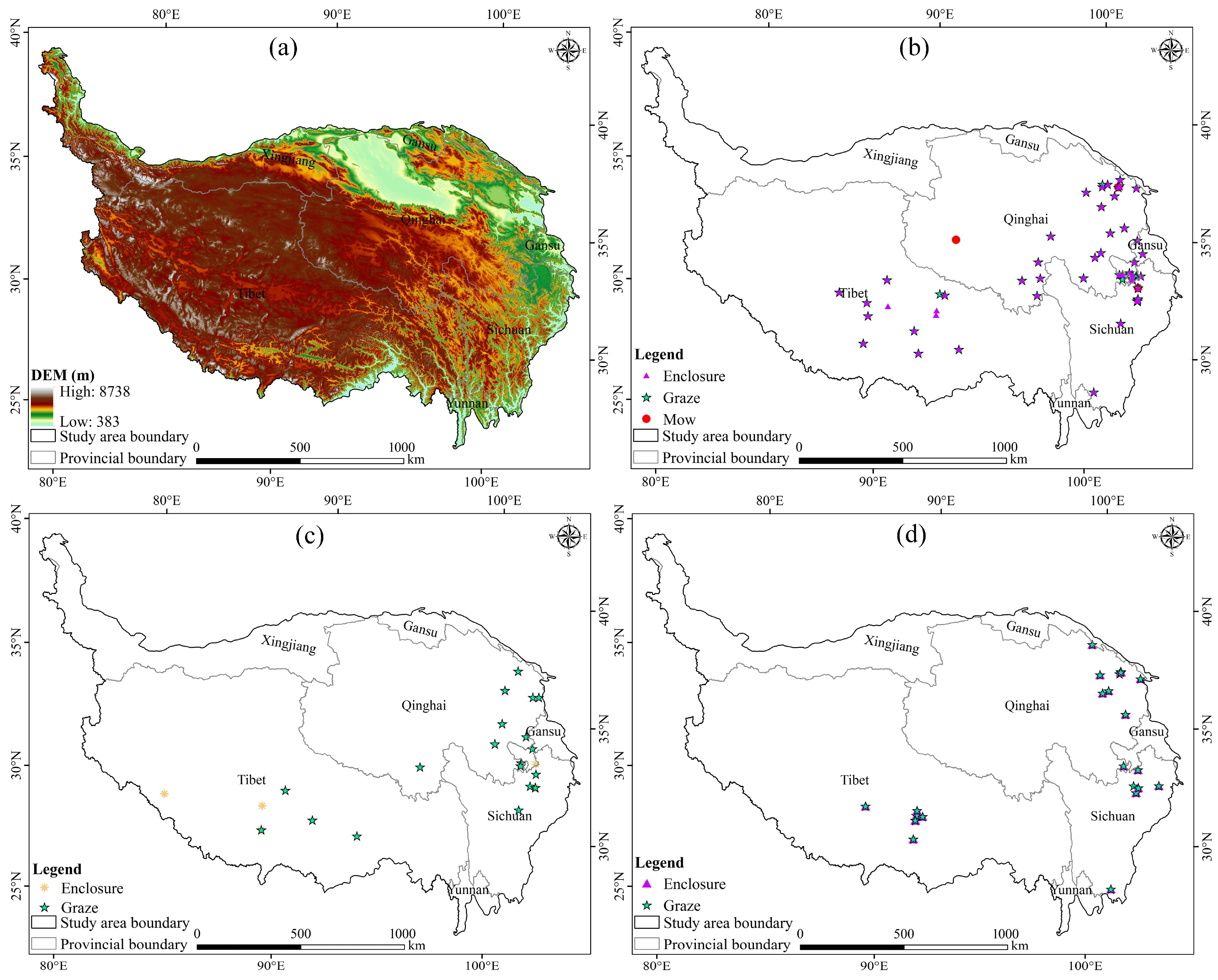
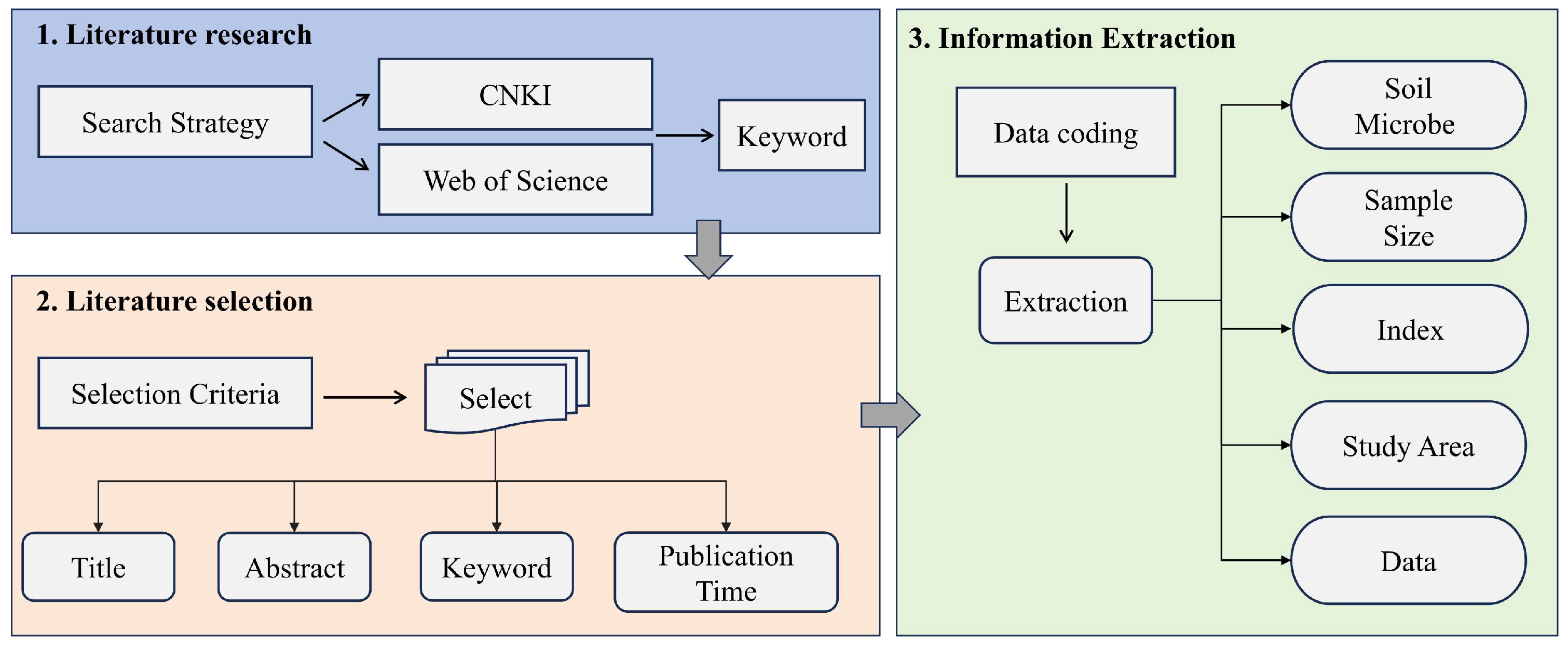

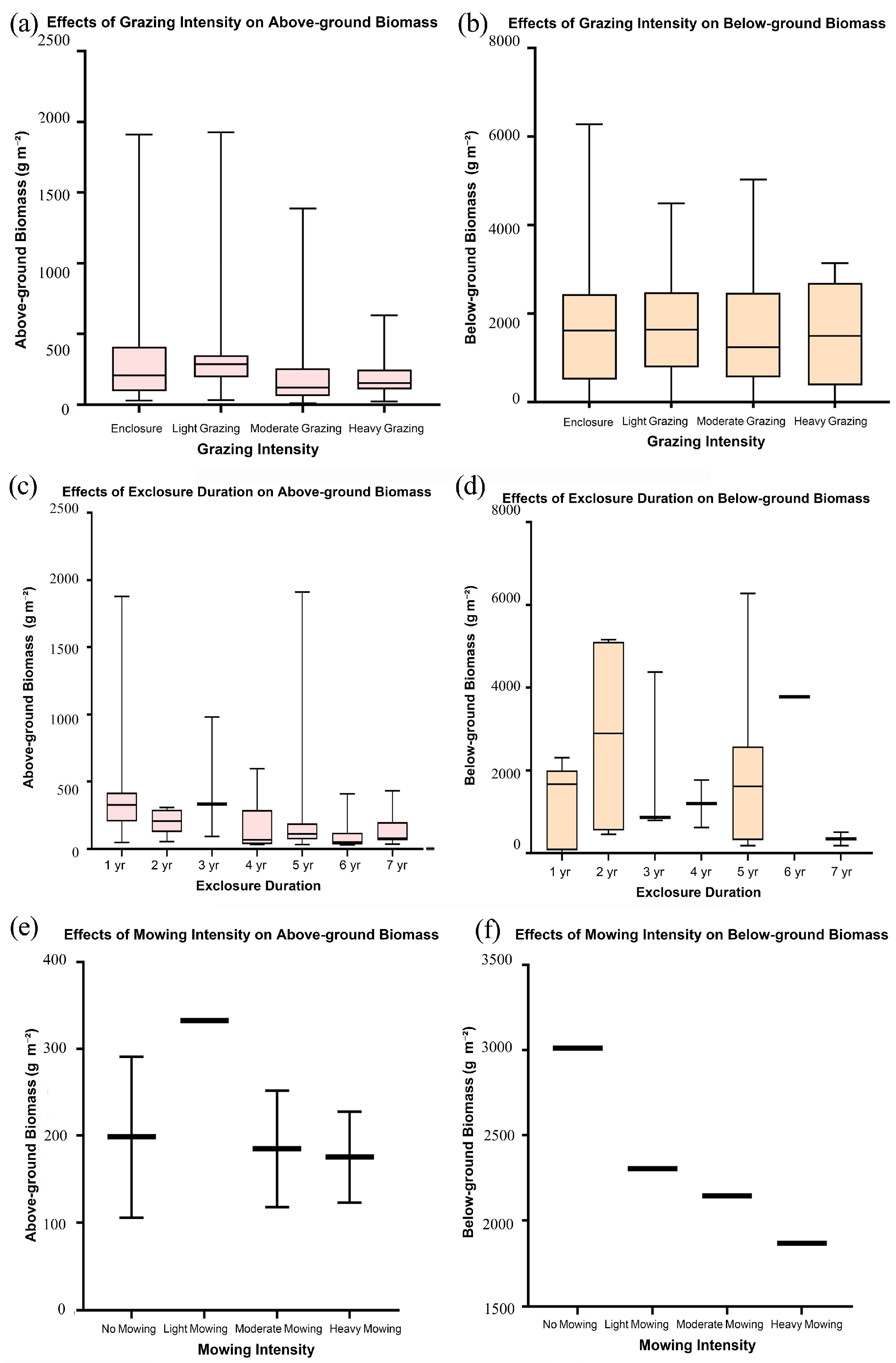
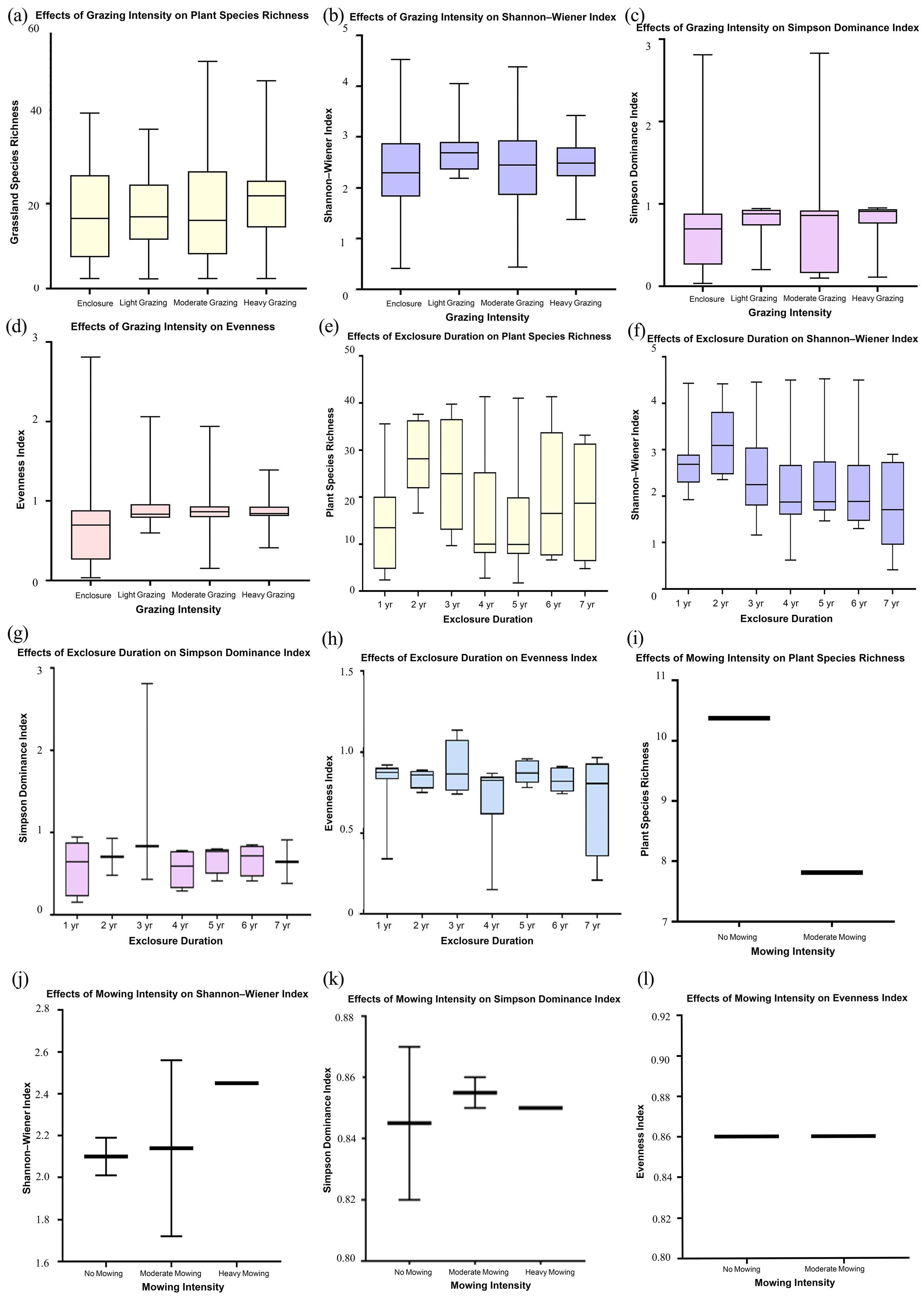
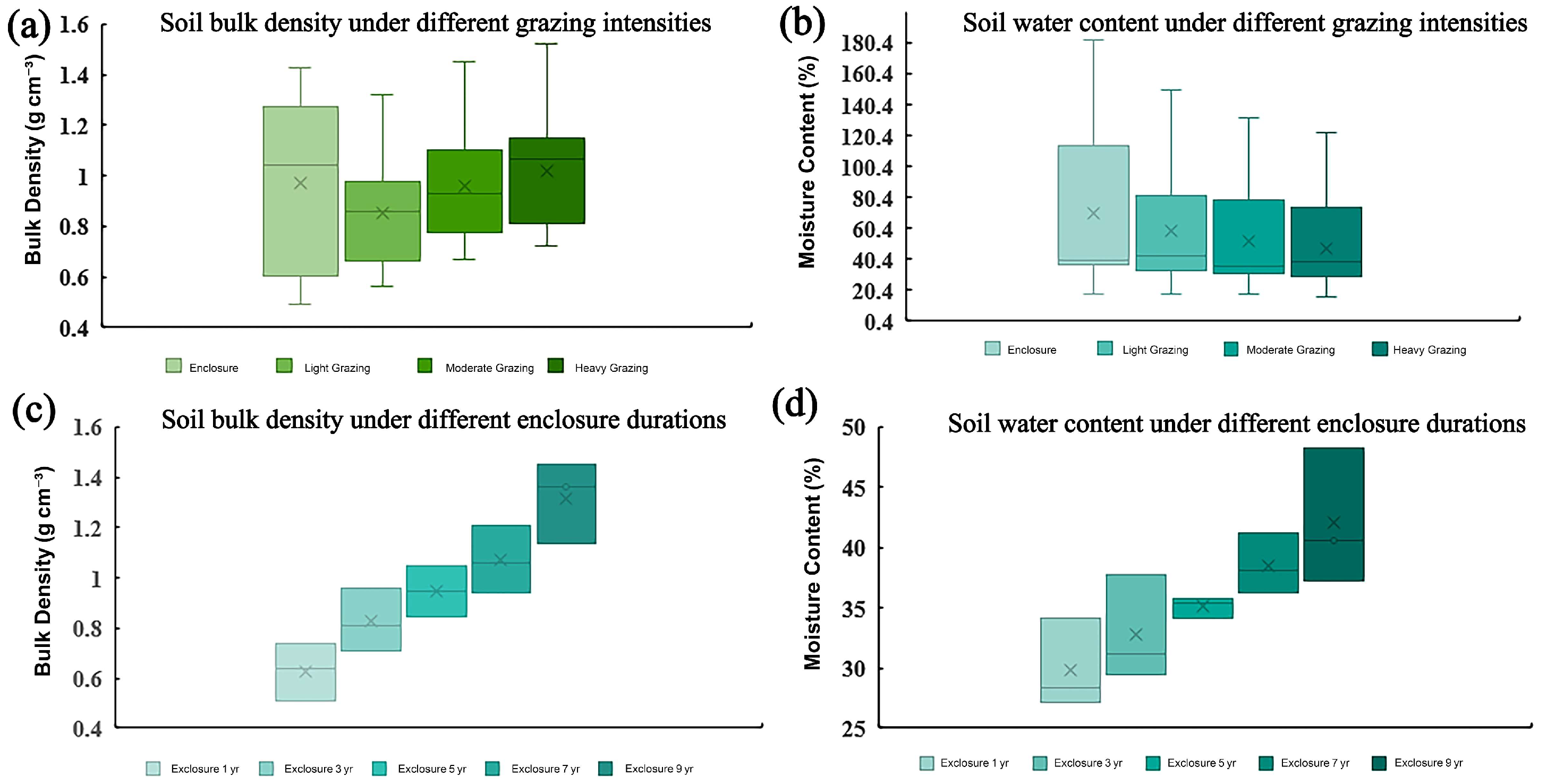

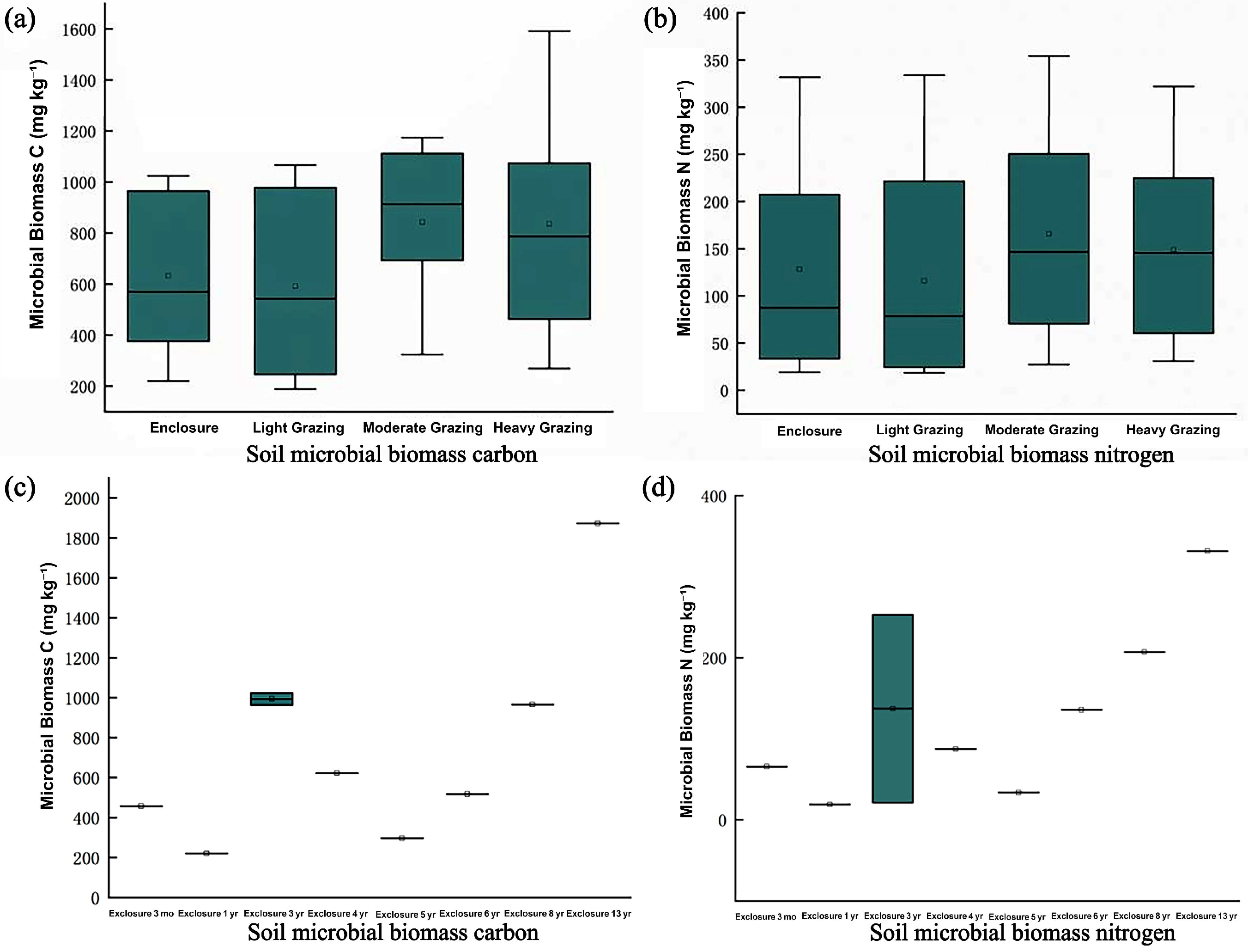

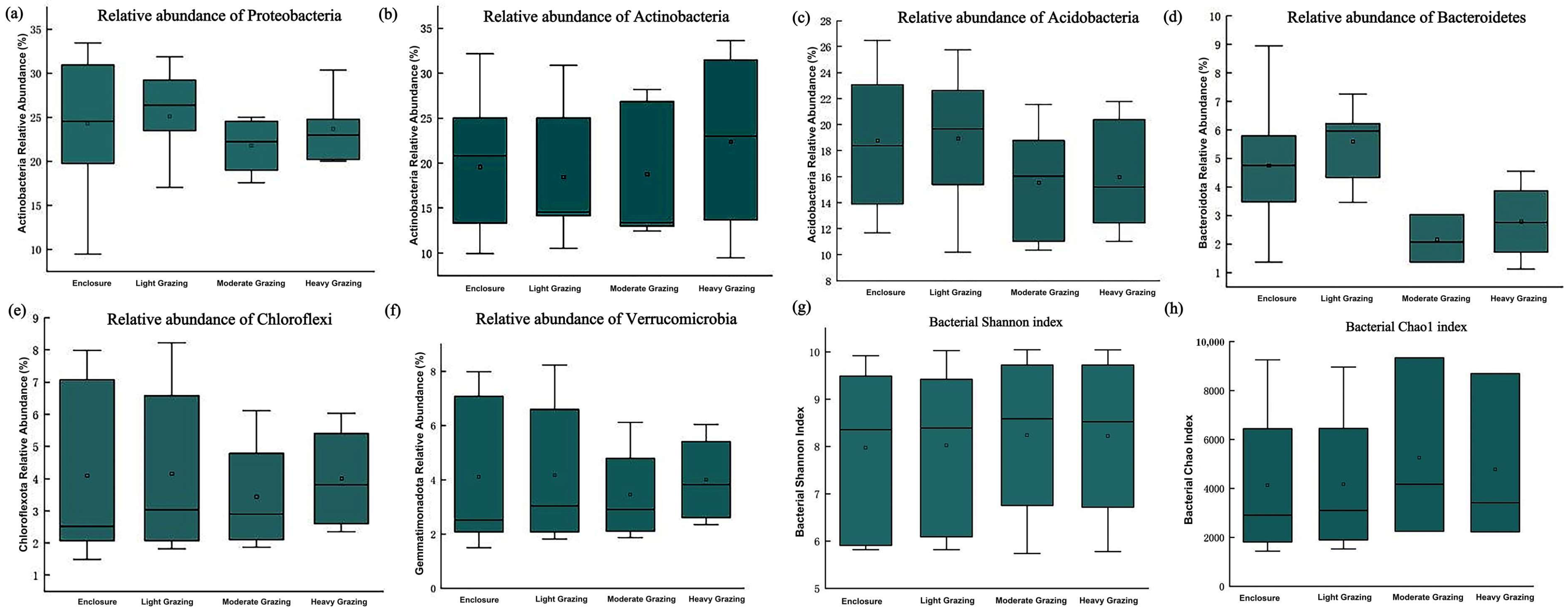
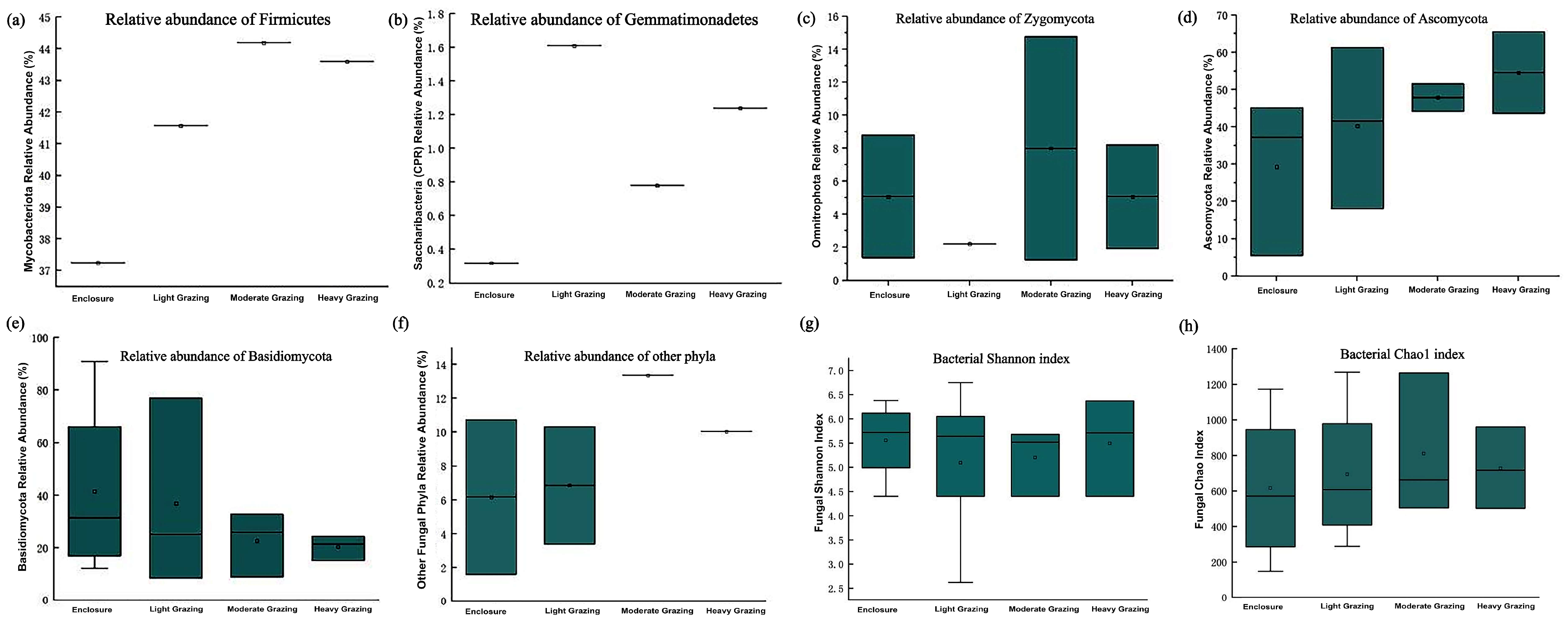
Disclaimer/Publisher’s Note: The statements, opinions and data contained in all publications are solely those of the individual author(s) and contributor(s) and not of MDPI and/or the editor(s). MDPI and/or the editor(s) disclaim responsibility for any injury to people or property resulting from any ideas, methods, instructions or products referred to in the content. |
© 2025 by the author. Licensee MDPI, Basel, Switzerland. This article is an open access article distributed under the terms and conditions of the Creative Commons Attribution (CC BY) license (https://creativecommons.org/licenses/by/4.0/).
Share and Cite
Song, W. How Grazing, Enclosure, and Mowing Intensities Shape Vegetation–Soil–Microbe Dynamics of Qinghai–Tibet Plateau Grasslands: Insights for Spatially Differentiated Integrated Management. Land 2025, 14, 2122. https://doi.org/10.3390/land14112122
Song W. How Grazing, Enclosure, and Mowing Intensities Shape Vegetation–Soil–Microbe Dynamics of Qinghai–Tibet Plateau Grasslands: Insights for Spatially Differentiated Integrated Management. Land. 2025; 14(11):2122. https://doi.org/10.3390/land14112122
Chicago/Turabian StyleSong, Wei. 2025. "How Grazing, Enclosure, and Mowing Intensities Shape Vegetation–Soil–Microbe Dynamics of Qinghai–Tibet Plateau Grasslands: Insights for Spatially Differentiated Integrated Management" Land 14, no. 11: 2122. https://doi.org/10.3390/land14112122
APA StyleSong, W. (2025). How Grazing, Enclosure, and Mowing Intensities Shape Vegetation–Soil–Microbe Dynamics of Qinghai–Tibet Plateau Grasslands: Insights for Spatially Differentiated Integrated Management. Land, 14(11), 2122. https://doi.org/10.3390/land14112122





